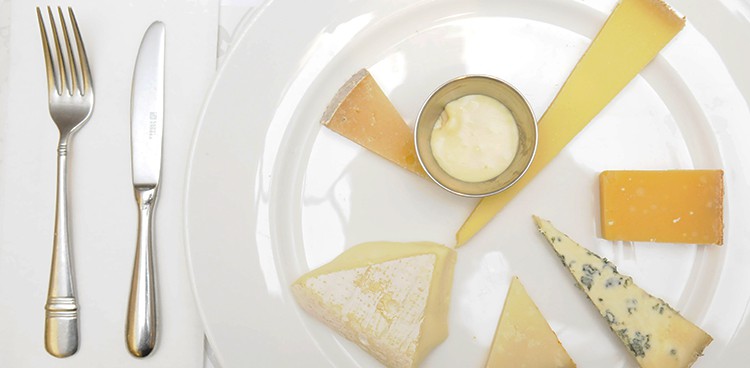
Tasting cheese may seem like a pretty elementary exercise—certainly it should be a pleasurable one. But accurately assessing a cheese like the pros do is not all that straightforward. Beyond flavor, there are numerous attributes to consider, including the look, texture, aroma, and feel of a cheese. Those of us on the cheese-judging circuit refer to the combination of these factors as the “eating quality” of a product. To judge fairly, I systematically pay attention to every dimension of a cheese. At the same time, I also have to recognize that I have preferences for certain cheese types and a bias against others; it’s important not to let my personal feelings get in the way of experiencing each cheese objectively.
LOOK
You might be surprised to learn that the appearance of a cheese carries relatively low weight
in judging circles. That’s because the scariest-looking cheeses can be the tastiest, while some of the prettiest can be altogether disappointing. I may respond instinctively to a good-looking wheel, but I know it’s not an indication of quality. A cheese that appears to be beautifully crafted can actually turn out to be alarmingly out of balance flavorwise. Conversely, I’ve met some dastardly looking cheeses that tasted sublime. Ultimately, it’s like the proverbial book and its cover—a winning exterior is no guarantee of a satisfying interior. That said, I do look for specific faults in appearance based on what I know to be the standard for each cheese. Until you know the basic standards, keep a good cheese reference guide handy.
SMELL
The aroma of a cheese is a significant part of assessing a cheese—often the first impression and almost always the final one. To get a good whiff, I hold the cut surface of a small piece of the cheese right up to my nose. Assuming that the appearance of a cheese is acceptable, the aroma should provide the taster the first critical evaluation. That smell will also give me a clue as to how the cheese will actually taste. For these reasons, the environment where you sample a cheese should be clean, with no other scents (such as strong perfumes or hand soap) getting in the way.

FEEL
Perhaps the best test in this category of texture is simply the way a cheese lies on the tongue and melts in your mouth. In judging situations, however, I often pick up a piece and break it apart to see how it separates. I’ll also give the cheese a firm but gentle poke to gauge its consistency. I notice the degree of resistance a knife blade encounters going through it. Keep in mind that the temperature of the cheese can greatly affect this resistance (not to mention its flavor, which is why serious cheesemongers, who offer customers samples to taste before buying, rest their wheels on the counter, not in cold storage).
TASTE
We rely on our taste receptors for assessing the four basic flavors of a cheese: saltiness, sweetness, sourness, and bitterness. A great many cheeses also exhibit a fifth dimension known as umami, which refers to a kind of full resonance of flavor, somewhat meaty and mouth coating. To allow the tongue to pick up all these components, always take a small, thin slice and let it luxuriate on your tongue, stimulating your saliva and taste receptors. Try to note the first “attack” of flavor, then how it evolves, and finally “the finish.” Discern whether the cheese flavor is balanced and well rounded—not too salty or too acidic. I think a cheese exhibits balance when the flavor of the milk comes through with no rough edges. A cheese that would be considered sharp might still have a balanced flavor profile, yet it might be a little more acidic, possibly a little salty. If there are bitter notes in the flavor they should be gentle. This flavor equilibrium can be a little difficult to explain in words, but when you taste it, you know it. Essentially, a well-balanced cheese should have a smooth flavor across the tongue and it should leave a pleasant finish of clean, wholesome milk.
I close my eyes when I taste cheese professionally; this helps me concentrate. Some cheese evaluators insist that you spit out the cheese as part of the tasting process. Personally, I have a hard time with that one. Unless the cheese is especially alarming in the mouth, I want to experience it fully.
After tasting many cheeses in one sitting, you can easily develop palate fatigue, a state in which it seems that all the cheeses taste the same. This is one of the fundamental reasons why the order in which you taste is important, even if you are having only a couple of cheeses in an informal setting. Though there are some guidelines available on those progressions—young to old, softer to harder, finish with the blues, etc.—a colleague of mine once recommended alternating cheese types when tasting a large grouping of cheeses to help avoid tasting burnout. Following this method, you differentiate between types of milk, texture, provenance, etc., so that you are tasting contrasting flavors rather than similar ones. I continue to follow this advice whenever possible.

GETTING INTO THE ACT
Whether you’re tasting cheese in a formal setting or simply having a selection for pleasure, it is helpful to keep your palate fairly neutral. The general recommendation is to avoid strongly flavored foods beforehand. It’s also wise to avoid drinking hot beverages so that you don’t risk scalding your tongue, thereby inhibiting some of your ability to taste.
I recommend that you keep your palate refreshed with water, the universal palate cleanser. If the flavor of a certain cheese still lingers beyond that H2O rinse, a small crumb of some simple unseasoned bread can work like a swab to help lift the fats and acids left behind by previous cheeses.
Another especially interesting practice in tasting cheeses that I’ve experienced many times is to use a platform of wine, beer, or even sake as a flavor booster. These beverages can help express some hidden nuances in a cheese, subtleties that might otherwise go unnoticed. Taking a little time to allow the palate to rest between bites is wise; try not to rush the experience, which isn’t good for you or accurate tasting. I recall one cheese competition where I tasted about 250 cheeses in two days—and with only one other judge! We got it done, though by the time we made it to the last couple of dozen cheeses we were beyond sated. Fortunately, most of the entries were very nice. Not a one did we expectorate.
Photos by Michael Harlan Turkell




